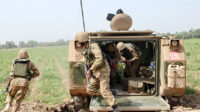On June 30, 2020, the U.S. Department of Labor (DOL)’s Occupational Safety and Health Administration (OSHA) reminds employers on hot and hazardous working conditions (outdoor/indoor); how to protect their employees from the risks and dangers of heat exposure.
Some of the ways as lay down by OSHA to mitigate heat hazards are:
- Water/ Rest/Shade; employers should encourage workers to drink water every 15 minutes, and take frequent rest breaks in shaded or air conditioned areas;
- New and temporary workers are most at risk to the hazards of excessive heat. Monitor new employees and offer them extra protections from elevated heat conditions until they are fully acclimatized;
- Create and post a plan; scheduled to protect news employees from the scorching heat and its resulting injuries and illnesses;
- Strenuous physical exertion increases body heat and workers’ risk of heat-related illness; evaluate the combination of body heat and environmental heat to determine if heat stress is a potential hazard.
OSHA/HHS’s Guidelines for Employers While Reopening Non-Essential Businesses
Recognize that serious heat-related illnesses can occur on normal summer days, when temperatures are not extreme. A good rule of thumb is that worker should know the additional protective measures whenever the Heat Index is 80 degrees (27 degrees C) Fahrenheit (F) or above.
Indoor industries, such as kitchens, laundries, and warehouses, can also become dangerously hot. Increase ventilation, use cooling fans, and whenever possible schedule work at a cooler time of the day. Ensure adequate good planning and supervision to keep workers safe in the heat; and train workers on the hazards of heat exposure and how to prevent illness.
Briefing and Training
A brief on heat stress and training employees how to keep safe during the hot weather conditions is important including the explanation of common occupational exposures, symptoms of heat illness, first aid measures to provide while waiting for help, proactive engineering controls and work practices to reduce workers’ exposure to heat.
Occupational Exposure Values (OELs)
2020 ACGIH Threshold Limit Values (TLVs) and Biological Exposures Indices (BEIs) and Heat Stress and Strain
There are many issues that surrounds on the management of heat related stresses or strains that result in heat related illnesses. Wet-Bulb Globe Temperature (WBGT) based exposure limits on the ability of most healthy, acclimatized workers to sustain a heat stress exposure, cases of heat strokes and other exertion heat illnesses may occur below TLV.
The goal of TLVs is to maintain body core temperature within + 1 degree C of normal (37 degrees C) for average person. Body core temperature can exceed 38.3 C under certain circumstances with selected populations, environmental and physiologic monitoring. and other controls.
A program of heat stress management includes:
- Acclimatization
- Early recognition of symptoms & first aid treatment
- Personal Risk factors to be discussed in personal (confidential)
No Specific Standard on Heat Stress
OSHA does not have a specific standard that covers working in hot environments. OSHA has a General Duty Clause within the OSH Act that states “employers have a duty to protect workers from recognized serious hazards in the workplace that include heat–related hazards”
Elements of managing the heat stress provide a framework to discuss the management of heat stress. There are schedules for operational acclimatization; work recovery cycles and other should be carried out for the exposures to occupational heat stresses. It takes time when you see the results while monitoring closely.
It has been observed that there is no reasonable heat stress management program protecting 100% against exertion heat stroke as such, other measures must be in place to identify and respond when heat stroke occurs.
The WBGT-based occupational exposure limits (OELs). OSHA recommends work and recovery cycles appropriate to a site’s OSH program and should cover the related site heat stroke mitigation plan.
Treating Corona Virus Using Dexamthasone: A Cheap Way to Treat COVID-19
Heat Index
The heat index is a measure of how hot it feels when relative humidity is taken into account along with the actual air temperature. It is important to note that heat index values were devised for shady, light wind conditions, that exposure to full sunshine can increase heat index values by up to 15°F. The National Weather Service uses the heat index values to issue heat alerts to the general public. However, workers in hot environments experience heat stress from a combination of environmental factors and metabolic heat from the tasks they are performing. Therefore, OSHA-modified heat index cutoffs; used in the appropriated heat index-associated protective measure specifically for worksites.
NIOSH Recommended Limits (RELs)
The National Institute of Health (NIOSH) recommends the use of wet bulb globe temperature (WBGT) to determine the Recommended Exposure Limits (RELs) for acclimatized workers and the Recommended Alert Limits (RALs) for unacclimatized workers in hot environments. However, we realize that workers and many small businesses will not have access to the resources necessary to determine WBGT. In these cases using the heat index is a viable alternative. WBGT is determined by measuring dry air temperature, humidity, and radiant energy; and used to calculate a thermal load on the worker. While the literature provides plenty of evidence regarding WBGT’s accuracy and common usage in industrial settings; the simplicity of the heat index makes it a good option for many outdoor work environments as long as there are no additional radiant heat sources, such as, fires or hot machinery.
Corona Virus-19: An Understanding of the Production-number R0
References:
- Protecting new workers, web page at: https://www.osha.gov/SLTC/heatstress/protecting_newworkers.html
- Heat Recognition, web page at: https://www.osha.gov/SLTC/heatstress/heat_hazardrecognition.html.
- An Overview: Working in outdoor and Indoor Heat Environments, web page at: https://www.osha.gov/SLTC/heatstress/.
- Heat Stress, web page at: https://www.cdc.gov/niosh/topics/heatstress/default.html.
- S. Department of Labor Reminds Employers of Important Protections for Working Safely in Summer Heat, web page at: https://content.govdelivery.com/accounts/USDOL/bulletins/2935dd5.
- Engineering Controls, Work Practices, and Personal Protective Equipment, webpage, at: https://www.osha.gov/SLTC/heatstress/controls.html
- Planning and Supervision, web page at: https://www.osha.gov/SLTC/heatstress/planning.html
- Criteria for a Recommended Standard Occupational Exposure to Heat and Hot Environments, web page at: https://www.cdc.gov/niosh/docs/2016-106/pdfs/2016-106.pdf?id=10.26616/NIOSHPUB2016106.
- Overview: Working in out and Indoor Heat Environments, web page at: https://www.osha.gov/SLTC/heatstress/index.html.
Stay tuned to Baaghi TV for the latest news and updates!






